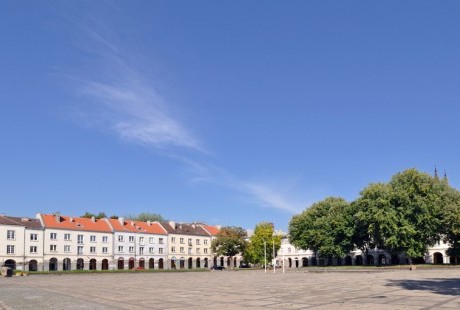Old Market Square , Lodz
The oldest Lodz square is the Old Town market. The transformations that this fragment of Lodz has undergone are so vast it is now difficult to imagine not only the look of the medieval little town, but even the architecture from before World War 2. The tract from Piotrkow to Lęczyca and the local roads to Lutomiersk or Brzeziny used to pass across the market. Behind its southern front spread a mill pond, supplied by the Lodka rivulette. The houses, including the simple town hall used to be built of wood for centuries. In was only in the 19th c. that brick buildings were raised there, with simple Classicist decor.
In the last century the Old Town became the district peopled almost entirely by the Jewish population. They also used to dwell around the market, and one of the houses used to belong to Kalman Poznanski, the father of the famous entrepreneur. In the western frontage there were stalls, designed by H. Marconi, the local trade centre, while in nearby ul. Wolborska rose a large synagogue. During the war the Old Town area was the centre of the ghetto. After its extermination, according to the designs prepared by the occupant the demolition of the houses around the square was begun. The works were continued after 1945.
The market received a totally new shape in the mid-1950s, when the building of the Social-Realist arcaded houses was completed (des. by R. Karlowicz with a team). Their form referred to the historical architecture of many other Polish cities, but not the old Lodz. In 1998 a memorial stone was placed in the market to commemorate the 575th anniversary of the foundation the the city of Lodz. The square has remained to be called Staromiejski (Old Town Square), even though it is surrounded by the post-war modern housing estate and the park. The only trace of the past gone by are the red towers of the nearby church of the Assumption of the Virgin Mary, peering over the houses adjacent to the market. The building yet belongs to still another fragment of old Lodz - Plac Koscielny (Church Square).
After 1945, the chapel, along with the whole area of the Old Evangelical - Augsburg Cemetery, was severely vandalised and damaged in a series of robberies - several coffins in the crypt were destroyed. The condition of the chapel worsened considerably before the Conservatory Authority became interested in the monument in the 1970s. They executed a detailed inventory, walled up windows, and surrounded the chapel with a fence. Despite these precautions, the condition of the chapel has continued to deteriorate.




